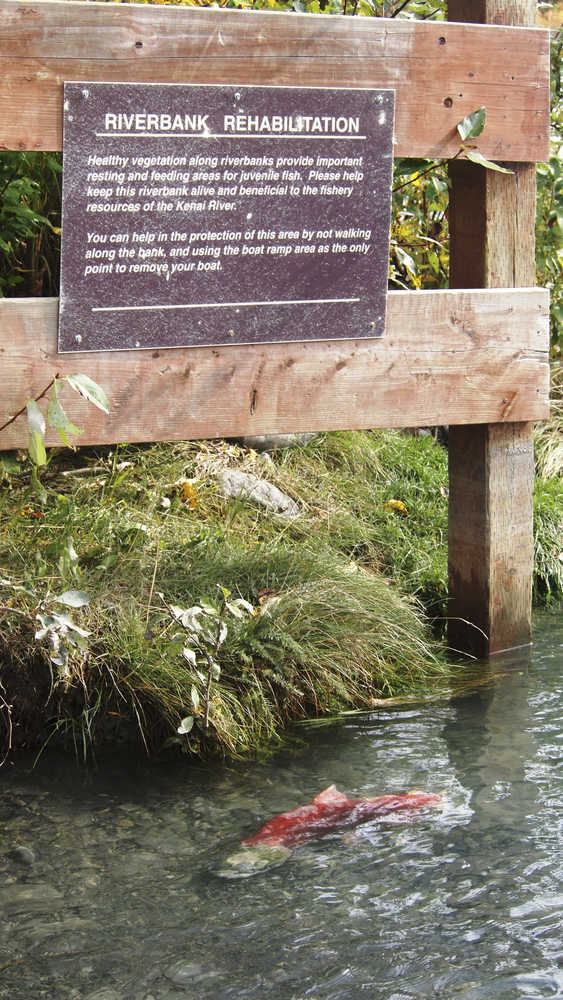It’s that magical time of year once again when the salmon are flooding through the Kenai River and its tributaries. People and wildlife alike flock to the shores in hopes of catching their fill of the riches that the waters provide. It’s wonderful to see so many people uniquely enjoying what nature has to offer.
What’s equally important are the efforts we can put forward to ensure that the emerald waters of the Kenai River remain healthy. Littering and polluting are both common problems that come to mind, but what about those weird rules about river banks? All of the public fishing facilities, whether city, state or federal, have signs telling you to stay off the river bank and its vegetation.
Why is this necessary? Seems a little over the top for one pair of boots. But we’re talking the salmon season — hundreds, upon hundreds of boots each year trampling along the shore, aching to hook a red. What will be left at the end of August when everything is said and done?
Well, typically what’s left is a huge case of bank erosion. Erosion is the natural process of wearing away the earth, in this case, bank sediment. Wind and water are two common agents for erosion in the wild, usually at glacially slow rates. People, however, can speed up erosion where normally it would take decades to change, devastating habitats and salmon alike.
As an intern at the Kenai National Wildlife who hails from Mississippi, riverbank erosion is not an unfamiliar issue to me. Boat wakes and river bank trampling are both destructive acts that increase erosion on the East and West coasts. However, unlike the Kenai River, the muddy Mississippi doesn’t support salmon that require pristine, flowing waters.
Trees, shrubs and grasses that make up riparian vegetation depend on the land beside the river. Water quality, fish and invertebrate habitats, flood control, and bank stabilization are only a few of the important roles that riparian vegetation plays.
With the vegetation removed, the natural buffer zone that trapped sediment and created new bank buildup is gone and erosion rates increase. Without cover, young fish are left without habitat to safely avoid predation. Lack of riparian vegetation and the receding of banks can drastically change water quality, as well as increase or decrease water velocity to dangerous levels. Increased velocity of water flow straightens and channelizes streams. The quickened waters can carry away salmon eggs from their gravel nests (called redds) and prematurely rush young salmon downstream into waters they aren’t prepared for.
Conversely, widened banks from erosion can decrease stream velocity and trap sediment on redds, decreasing oxygen flow to the eggs. This event in particular is a huge killer of salmon eggs. The growth and spawning of salmon are sensitive to changes in temperature and oxygen levels that erosion influences as well.
So what can we do? Avoid bank trampling by using board walks and designated ladders that provide access for fishing. If you’re unfamiliar with an area that you intend to fish, always come prepared with the right equipment. Trampling on the banks just because the water was too deep, and hip waders were mistakenly brought instead of chest waders, is no excuse for the banks (and fish) to suffer. Minimizing your boat wakes within shallow waters is a great help as well.
While it may seem like an inconvenience at times to abide by these rules, it’s important to remember that it is not about the seemingly insignificant impacts that we make as individuals, but the sum of those impacts as a community. Very simple choices determine whether our pursuit of salmon is benign or has negative consequences on fish populations. Help keep the rivers clear and beautiful for our beloved chrome jewels as they return home.
Isabela Vilella currently participates in the Career Discovery Internship Program. She is a junior at Mississippi State University, majoring in Wildlife, Fisheries and Aquaculture Sciences. You can find more information about the Kenai National Wildlife Refuge at http://kenai.fws.gov or http://www.facebook.com/kenainationalwildliferefuge.

